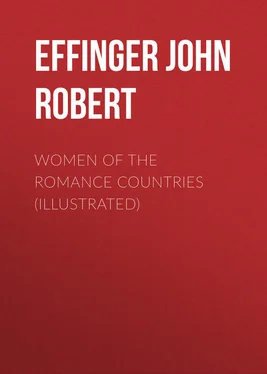John Effinger - Women of the Romance Countries (Illustrated)
Здесь есть возможность читать онлайн «John Effinger - Women of the Romance Countries (Illustrated)» — ознакомительный отрывок электронной книги совершенно бесплатно, а после прочтения отрывка купить полную версию. В некоторых случаях можно слушать аудио, скачать через торрент в формате fb2 и присутствует краткое содержание. Жанр: История, foreign_antique, foreign_prose, на английском языке. Описание произведения, (предисловие) а так же отзывы посетителей доступны на портале библиотеки ЛибКат.
- Название:Women of the Romance Countries (Illustrated)
- Автор:
- Жанр:
- Год:неизвестен
- ISBN:нет данных
- Рейтинг книги:4 / 5. Голосов: 1
-
Избранное:Добавить в избранное
- Отзывы:
-
Ваша оценка:
- 80
- 1
- 2
- 3
- 4
- 5
Women of the Romance Countries (Illustrated): краткое содержание, описание и аннотация
Предлагаем к чтению аннотацию, описание, краткое содержание или предисловие (зависит от того, что написал сам автор книги «Women of the Romance Countries (Illustrated)»). Если вы не нашли необходимую информацию о книге — напишите в комментариях, мы постараемся отыскать её.
Women of the Romance Countries (Illustrated) — читать онлайн ознакомительный отрывок
Ниже представлен текст книги, разбитый по страницам. Система сохранения места последней прочитанной страницы, позволяет с удобством читать онлайн бесплатно книгу «Women of the Romance Countries (Illustrated)», без необходимости каждый раз заново искать на чём Вы остановились. Поставьте закладку, и сможете в любой момент перейти на страницу, на которой закончили чтение.
Интервал:
Закладка:
Divorce was a very simple matter at this time so far as the husband was concerned, for he it was who could repudiate his wife, disown her, and send her from his door for almost any reason, real or false. In earlier times, at the epoch when the liberty of the citizen was the pride of Rome, marriage almost languished there on account of the misuse of divorce, and both men and women were allowed to profit by the laxity of the laws on this subject. Seneca said, in one instance: "That Roman woman counts her years, not by the number of consuls, but by the number of her husbands." Juvenal reports a Roman freedman as saying to his wife: "Leave the house at once and forever! You blow your nose too frequently. I desire a wife with a dry nose." When Christianity appeared, then, the marriage tie was held in slight consideration, and it was only after many centuries and by slow degrees that its sanctity was recognized, and its rights respected. While, under the Roman law, both men and women had been able to get a divorce with the same ease, the feudal idea, which gave all power into the hands of the men, made divorce an easy thing for the men alone, but this was hardly an improvement, as the marriage relation still lacked stability.
It must not be supposed that all the mediæval ideas respecting marriage and divorce and the condition of women in general, which have just been explained, had to do with any except those who belonged in some way to the privileged classes, for such was not the case. At that time, the great mass of the people in Europe-men and women-were ignorant to the last degree, possessing little if any sense of delicacy or refinement, and were utterly uncouth. For the most part, they lived in miserable hovels, were clothed in a most meagre and scanty way, and were little better than those beasts of burden which are compelled to do their master's bidding. Among these people, rights depended quite largely upon physical strength, and women were generally misused. To the lord of the manor it was a matter of little importance whether or not the serfs upon his domain were married in due form or not; marriage as a sacrament had little to do with these hewers of wood and drawers of water, and they were allowed to follow their own impulses quite generally, so far as their relations with each other were concerned. The loose moral practices of the time among the more enlightened could be but a bad example for the benighted people of the soil; consequently, throughout all classes of society there was a degree of corruption and immorality which is hardly conceivable to-day.
So far as education was concerned, there were but a few who could enjoy its blessings, and these were, for the most part, men. Women, in their inferior and unimportant position, rarely desired an education, and more rarely received one. Of course, there were conspicuous exceptions to this rule; here and there, a woman working under unusually favorable circumstances was really able to become a learned person. Such cases were extremely rare, however, for the true position of woman in society was far from being understood. Schools for women were unknown; indeed, there were few schools of any kind, and it was only in the monasteries that men were supposed to know how to read and write. Even kings and queens were often without these polite accomplishments, and the right of the sword had not yet been questioned. Then, it must be taken into consideration that current ideas regarding education in Italy in this early time were quite different from what they are to-day. As there were no books, book learning was impossible, and the old and yellowed parchments stored away in the libraries of the monasteries were certainly not calculated to arouse much public enthusiasm. Education at this time was merely some sort of preparation for the general duties of life, and the nature of this preparation depended upon a number of circumstances.
To make the broadest and most general classification possible, the women of that time might be divided into ladies of high degree and women of the people. The former were naturally fitted by their training to take their part in the spectacle of feudal life with proper dignity; more than that, they were often skilled in all the arts of the housewife, and many times they showed themselves the careful stewards of their husbands' fortunes. The women of the people, on the other hand, were not shown any special consideration on account of their sex, and were quite generally expected to work in the fields with the men. Their homes were so unworthy of the name that they required little care or thought, and their food was so coarse that little time was given to its preparation. Simple-minded, credulous, superstitious in the extreme, with absolutely no intellectual uplift of any kind, and nothing but the sordid drudgery of life with which to fill the slow-passing hours, it is no wonder that the great mass of both the men and the women of this time were hopelessly swallowed up in a many-colored sea of ignorance, from which, with the march of the centuries, they have been making slow efforts to rise. So the lady sat in the great hall in the castle, clad in some gorgeous gown of silk which had been brought by the patient caravans, through devious ways, from the far and mysterious East; surrounded by her privileged maidens, she spun demurely and in peace and quiet, while out in the fields the back of the peasant woman was bent in ceaseless toil. Or again, the lady of the manor would ride forth with her lord when he went to the hunt, she upon her white palfrey, and he upon his black charger, and each with hooded falcon on wrist; for the gentle art of falconry was almost as much in vogue among the women as among the men of the time. Often it happened that during the course of the hunt it would be necessary to cross a newly planted field, or one heavy with the ripened grain, and this they did gaily and with never a thought for the hardship that they might cause; and as they swept along, hot after the quarry, the poor, mistreated peasant, whether man or woman, dared utter no word of protest or make moan, nor did he or she dare to look boldly and unabashed upon this hunting scene, but rather from the cover of some protecting thicket. Scenes of this kind will serve to show the great gulf which there was between the great and the lowly; and as there was an almost total lack of any sort of education in the formal sense of the word, it will be readily understood that all that education could mean for anybody was that training which was incident to the daily round of life, whatever it happened to be. So the poor and dependent learned to fear and sometimes to hate their masters, and the proud and haughty learned to consider themselves as superior and exceptional beings.
With society in such a state as this, the question will naturally arise: What did the Church do under these circumstances to ameliorate the condition of the people and to advance the cause of woman? The only answer to this question is a sorry negative, as it soon becomes apparent, after an investigation of the facts, that in many cases the members of the clergy themselves were largely responsible for the wide prevalence of vice and immorality. It must be remembered that absolution from sin and crime in those days was but a matter of money price and that pardons could be easily bought for any offence, as the venality of the clergy was astounding. The corruption of the time was great, and the priests themselves were steeped in crime and debauchery. In former generations, the Church at Rome had many times issued strict orders against the marriage of the clergy, and, doubtless as one of the consequences of this regulation, it had become the custom for many of the priests to have one or more concubines with whom they, in most cases, lived openly and without shame. The monasteries became, under these conditions, dens of iniquity, and the nunneries were no better. The nunnery of Saint Fara in the eleventh century, according to a contemporary description, was no longer the residence of holy virgins, but a brothel of demoniac females who gave themselves up to all sorts of shameless conduct; and there are many other accounts of the same general tenor. Pope Gregory VII. tried again to do something for the cause of public morality, in 1074, when he issued edicts against both concubinage and simony-or the then prevalent custom of buying or selling ecclesiastical preferment; but the edict was too harsh and unreasonable with regard to the first, inasmuch as it provided that no priest should marry in the future, and that those who already possessed wives or concubines were to give them up or relinquish their sacred offices. This order caused great consternation, especially in Milan, where the clergy were honestly married, each man to one wife, and it was found impossible to exact implicit obedience to its requirements.
Читать дальшеИнтервал:
Закладка:
Похожие книги на «Women of the Romance Countries (Illustrated)»
Представляем Вашему вниманию похожие книги на «Women of the Romance Countries (Illustrated)» списком для выбора. Мы отобрали схожую по названию и смыслу литературу в надежде предоставить читателям больше вариантов отыскать новые, интересные, ещё непрочитанные произведения.
Обсуждение, отзывы о книге «Women of the Romance Countries (Illustrated)» и просто собственные мнения читателей. Оставьте ваши комментарии, напишите, что Вы думаете о произведении, его смысле или главных героях. Укажите что конкретно понравилось, а что нет, и почему Вы так считаете.












